

Toaster? She? Driverless shuttle creates identity, fans during Sac State trial run
SACRAMENTO'S UNIVERSITY
Dixie Reid
“I foresee the ability to have a ‘hail-able’ autonomous vehicle service the needs of the entire campus population.”
Mass transportation’s future ambled up and down Moraga Way at a not-so-breathtaking speed of 5 mph.
Olli – the diminutive, driverless shuttle that University President Robert S. Nelsen declared is a “she” – made her campus debut in late February, welcomed by such dignitaries as Congresswoman Doris Matsui and Sacramento Mayor Darrell Steinberg.
A pair of the electric, eight-seater Olli transports, with an onboard human attendant, carried passengers along the route between Yosemite and Amador halls for three months.
Sac State won the chance to host the world’s first 3D-printed, co-created autonomous vehicles after besting other entries in Local Motors’ inaugural Olli Fleet Challenge. The Arizona-based company had invited municipalities, campuses, and designated districts to propose short-term, local uses for Olli.
In a perfect Olli world, a fleet of such futuristic shuttles would operate throughout the 300-acre campus and beyond, says Tony Lucas, senior director of University Transportation and Parking Services (UTAPS).
“I foresee the ability to have a ‘hail-able’ autonomous vehicle service the needs of the entire campus population,” he says. “When state regulations permit their operation on public roads, I’d love for them to start at the residence halls, drive along the perimeter road, and service the 65th Street light rail station, 24 hours a day.”
Sac State partnered with the Sacramento Area Council of Governments (SACOG) to secure the Olli Fleet Challenge win. SACOG paid the University’s cost of $88,000 to implement the test project.
The campus community responded favorably to the novelty of a driverless shuttle that somewhat resembles a toaster, although ridership was low, Lucas said. He blamed the long spell of late winter rains.
Likewise, visiting transportation analysts and planners were impressed with Olli.
“We provided the Sacramento region an opportunity to experience autonomous vehicle operations firsthand,” Lucas says. “Sacramento State will have helped people to dream what is possible in their
own communities.”
Olli also served as a classroom-on-wheels for students in Professor Ghazan Khan’s transportation engineering class. They collected data on public opinion toward autonomous vehicle use and technology.
If Olli had a failing, Lucas noted, it was the lack of a wheelchair ramp.
“We missed out on serving an important community on campus. To me, it won’t be a true success until we provide service to the entire Sac State community,” Lucas says.
